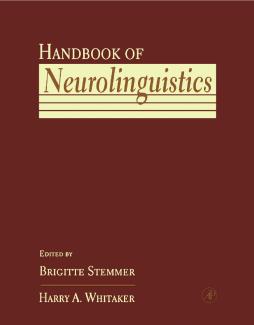
Additional Information
Book Details
Abstract
The Handbook of Neurolinguistics is a state-of-the-art reference and resource book; it describes current research and theory in the many subfields of neurolinguistics and its clinical application. Thorough and clearly written, the handbook provides an excellent overview of the field of neurolinguistics and its development.
The book is organized into five parts covering the history of neurolinguistics, methods in clinical and experimental neurolinguistics, experimental neurolinguistics, clinical neurolinguistics, and resources in neurolinguistics. The first four parts contain a wide range of topics which discuss all important aspects of the many subfields of neurolinguistics. Also included are the relatively new and fast developing areas of research in discourse, pragmatics, and recent neuroimaging techniques. The resources section provides currently available resources, both traditional and modern. The handbook is useful to the newcomer to the field, as well as the expert searching for the latest developments in neurolinguistics.
- Clearly written and well organized
- Provides extensive resources
- Discusses both history and current research
- Covers the many subfields of neurolinguistics as well the developing areas of research
"...I highly recommend this volume both for beginners approaching neurolinguistics for the first time (it is easy to read, rich in details, but at the same time linear in its development) and for experienced scientists (it is a gold mine of historical, clinical experimental, and methodological information)." --Brain and Language
"The Handbook of Neurolinguistics and the whole field as represented here turned out to be (at least in most of the 47 articles) a valuable source of a mature field and of new information...The understanding of grammar in neuroscientific terms will be the most exciting adventure of neurolinguistics for future decades. This excellent book prepares us for that task." --Contemporary Psychology, 1999, Vol. 44, No. 4
"...this systemic, clear and coprehensive handbook organized in 50 accurate and swift chapters dealing with the most 'classical' neurolinguistic topics and also with the most innovative ones... is all in all highly informative and at the same time pleasant to read, since all the authors (more than 70) have opted for a clear and simple style bereft of extreme, unneeded technicalities. As editors of this notable volume, Brigitte Stemmer and Hary A. Whitaker deserve recognition for having conceived and successfully completed a comprehensive, methodological work which also takes into consideration the most recent experimental, clinical and therapeutical methods appleid int he field of neurolinguistics." --Neuropsychologia, 1999, Vol. 37
